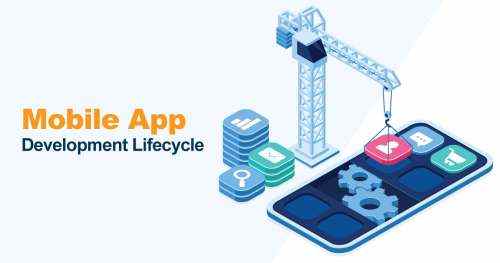
UNDERSTANDING THE MOBILE APP DEVELOPMENT LIFECYCLE
Mobile app development is not rocket science in today's day and age. Making a good mobile application, however, is a process that requires a very lengthy pre-planning process. It could be as simple as launching the IDE, putting a few items together, doing a quick round of screening, and uploading it to an App Store, all achieved in half a day's work, to create your mobile application. Or you can render it a deeply engaged process involving comprehensive up-front design, QA testing on a range of platforms, accessibility testing, a complete beta lifecycle, and then various forms of deploying it. Your vision is given form by the direction you chose. With that said, here is a look at the lifecycle of app creation and the priorities and obstacles along the way.
1. The Research
Even if yours is only for getting a mobile app presence, every app development starts with an idea. Refine the concept into an application on a solid basis. Make sure that your initial research covers your buyer persona's real demographics, motivations, activity trends and objectives. Keep the end-user in mind during each point of the process. Now, try to think of the lifecycle of your client, until their features are pinned. They need to be obtained, transformed, maintained and their loyalty nurtured after you meet them. In the end, you can understand how the digital product would be used by the client. Doing this will put you on a solid footing at the very beginning, and your transparency will give you and your investors much-needed confidence.
This phase is critical because you lay down the required groundwork during this phase for what is to come next. Before heading on to the next step, do your bit of intensive studies and strategizing. And evaluating competition is another essential part of this point. A thorough review of the software of your rival can assist you to find out what features are lacking in your software so that you can incorporate it into your app to make it pop out.
2. Wireframing
The next step is for the app to be registered and wireframed. While time is not on your side at this stage, it allows you to uncover usability problems by actually drawing thorough sketches of the envisaged product. Sketching does a great deal more than just tracing the moves. It can be a strong instrument for cooperation and interaction. Wireframing will help refine the concepts when you're finished sketching and organise all elements of the design correctly. In this initial step, you can resolve any technological limitations found in the context of back-end development. Now, try to build a better picture of how a working app can fuse the suggested designs and ideas. To show the relationship across each screen as well as how the users can move through the app, you can also establish a roadmap or a template. Look for ways to integrate the brand, concentrate on the user experience and take into account the variations in how people use a mobile phone app and a mobile browser.
3. Technical Feasibility Assessment
Now though, you may well have a good understanding of the graphics, but you must still take into account if the back-end frameworks would be able to maintain the interface of the app. You need to gain access to public data by accessing open APIs to know if the concept of your application is technologically possible. There will be various specifications for an app, based on its size (smartphone, tablet, wearables, etc.) as well as the system (iOS, Android, etc.). The team will have fresh concepts for the app by the conclusion of this phase or have concluded that some of the preliminary functionality is not feasible. Brainstorm a little at this stage, ask questions, and check the status.
4. Prototype
Build a simple prototype. The keyword here is Rapid. Before and until you contact the Software and see how it functions and flows, you can't fully grasp the touch experience. But, to see if it works with the most popular use case, create a prototype that brings the app idea into the hands of a user as soon as possible. For this step, use rough and not detailed wireframes. If you are bringing stuff in the right direction, this will help you see. Include in this phase the stakeholders, enabling them to access the prototype will offer you their input and apply it in your work. And, also, the prototype will provide the first look at your app to various stakeholders and will help you verify the data you have collected.
5. Design
You can plunge into programming once you get this phase-out of the way. The connection between design elements is architected by your user experience ( UX) designer, while the user interface (UI) designer creates the app's look and feel. With its various review steps, this is a multi-step process. Blueprints and visual direction are what you get, reminding the engineers of the final product envisaged and how interaction can shift, feel and flow. This design process can be done in a single afternoon or can take a team a whole lot of hours, depending on the project scope and app budget. And by playing around with the layout of control, buttons and other graphic cues, remember to make several variations of a computer. The more your product differs, the greater the chances that your UX will be original. Designing applications can prove to be a multi-step process, and the results should be simple visual instructions that provide the final product with an abstraction.
6. Develop
Generally, the production process begins very early on. In reality, a working prototype is created after an idea gets some maturation in the conceptual stage, validating functionality, assumptions, and helping to provide an understanding of the scope of work.
The app goes through a series of phases as the production progresses. The core functionality, while present, is not verified in the initial stage. Seeing that the app is very buggy, there is no non-core functionality at this stage. In the second level, most of the proposed functionality is implemented. Ideally, the software has gone through light testing and bug fixing, but there may still be some problems. In this step, for further testing, the app is released to a certain group of external users. The app will pass to the deployment stage after the bugs in the second stage are patched, where it is ready for release.
Make note of the agile approach if yours is a complicated task where user requirements change frequently. Flexible preparation, progressive growth, early implementation and continuous changes are supported by this. A large framework can be split apart into smaller components, and each of these minor bits can be added to agile methodology.
7. Testing
It's a good way to check early and often in mobile app growth. Doing so will keep your final expenses down. The deeper you go through the growth cycle, the more expensive it becomes to patch bugs. When building the different test cases, relate to the original design and development documents.
Application testing is comprehensive, so ensure all the relevant aspects of it are covered by your team. Usability, functionality, protection, interface tests, stress, and performance should be checked for the application. You explore whether or not your mobile app works with your intended users during user acceptance testing. To test this, provide a few individuals in your target audience with your app and ask specific questions. You know your approach "works" after your application passes the user approval test, and further make your application available for a beta trial, either by the registration of previously established groups or an open request for participants. The reviews you get from beta users will assist you to find out if the features of the app perform well in a real-world situation.
8. Deployment
Your app is ready for submission. Select a day and initiate a formal launch. The rules for the release of an app are appropriate for various application stores. And note, this is not the end. Creation of apps doesn't stop at launch. Input will flood in when the application gets into the hands of consumers, and you will need to integrate the input into future iterations of the software. Updates and new features will be required for any app. Usually, the development cycle starts again as long as the first version of the software is released. To sustain your item, make sure you get the resources. Bear in mind that it is a long-term investment, aside from the money spent in creating a digital product.
The key thing to note is that a constant and continuing phase is the creation of apps. It just doesn't end with the release of the final production, it's just the beginning. More reviews and suggestions will come in as the app gets more users, and you will have to incorporate the requisite improvements in the form of potential app updates. Follow the above steps to make your app hit the pinnacle of success if this is your debut attempt at app growth. The mobile app development process is very intricate. Mobile app development companies and agencies are in great demand because the customer base for it is large. The back end of your mobile app is made by app developers using specialised mobile app development software and tools. Developing the apps we love and spend our days’ scourging is being created with a lot of care by mobile app development companies. Mobile app development companies in India have greatly evolved and are at par with others on a global scale.





